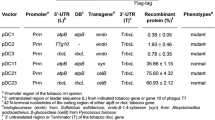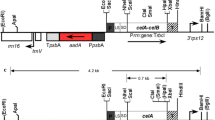Abstract
The high cost of recombinant enzymes for the production of biofuel from ligno-cellulosic biomass is a crucial factor affecting the economic sustainability of the process. The use of plants as biofactories for the production of the suitable recombinant enzymes might be an alternative to microbial fermentation. In the case of enzyme accumulation in chloroplasts, it is fundamental to focus on the issue of full photosynthetic efficiency of transplastomic plants in the field where they might be exposed to abiotic stress such as high light intensity and high temperature. Xylanases (EC 3.2.1.8), a group of enzymes that hydrolyse linear polysaccharides of beta-1,4-xylan into xylose, find an application in the biofuel industry favouring biomass saccharification along with other cell-wall degrading enzymes. In the present study, we analysed how a high level of accumulation of a thermostable xylanase in tobacco chloroplasts does not impact on photosynthetic performance of transplastomic plants grown outdoors. The recombinant enzyme was found to be stable during plant development, ex planta and after long-term storage.




Similar content being viewed by others
Abbreviations
- BSX:
-
Bacillus sp. xylanase
- TSP:
-
Total soluble proteins
- Chl:
-
Chlorophyll
- Car:
-
Carotenoids
- FM :
-
Maximum PSII fluorescence in the dark-adapted state
- F0 :
-
Minimum fluorescence in the dark-adapted state
- Fv :
-
Variable fluorescence
- PAM:
-
Pulse amplitude modulated fluorimetry
- PSII:
-
Photosystem II
References
Allahverdiyeva T, Aro E-M (2012) Photosynthetic responses of plants to excess light: mechanisms and conditions for photoinhibition, excess energy dissipation and repair. In: Eaton JJ, Tripathy BC, Sharkey TD (eds) Photosynthesis: plastid biology, energy conversion and carbon assimilation. Advances in photosynthesis and respiration. Springer, Dordrecht, pp 275–297
Anderson JM (1986) Photoregulation of the composition, function, and structure of thylakoid membranes. Annu Rev Plant Physiol Plant Mol Biol 37:93–136
Baldisserotto C, Ferroni L, Anfuso E, Pagnoni A, Fasulo MP, Pancaldi S (2007) Responses of Trapa natans L. floating laminae to high concentrations of manganese. Protoplasma 231:65–82
Baldisserotto C, Ferroni L, Zanzi C, Marchesini R, Pagnoni A, Pancaldi S (2010) Morpho-physiological and biochemical responses in the floating lamina of Trapa natans exposed to molybdenum. Protoplasma 240:83–97
Bally J, Nadai M, Vitel M, Rolland A, Dumain R, Dubald M (2009) Plant physiological adaptations to the massive foreign protein synthesis occurring in recombinant chloroplasts. Plant Physiol 150:1474–1481
Bhardwaj A, Leelavathi S, Mazumdar-Leighton S, Ghosh A, Ramakumar S, Reddy VS (2010) The critical role of N- and C-terminal contact in protein stability and folding of a family 10 xylanase under extreme conditions. Plos One 5:e11347
Borisjuk NV, Borjsiuk LG, Logendra S, Petersen F, Gleba Y, Raskin I (1999) Production of recombinant proteins in plant root exudates. Nat Biotechnol 17:466–469
Borkhardt B, Harholt J, Ulvskov P, Ahring BK, Jorgensen B, Brinch-Pedersen H (2010) Autohydrolysis of plant xylans by apoplastic expression of thermophilic bacterial endo-xylanases. Plant Biotechnol J 8:363–374
Bradford MM (1976) A rapid and sensitive method for the quantitation of microgram quantities of protein utilizing the principle of protein-dye binding. Anal Biochem 72:248–254
Conley AJ, Joensuu JJ, Richman A, Manassa R (2011) Protein body-inducing fusions for high-level production and purification of recombinant proteins in plants. Plant Biotechnol J 9:419–433
Doran PM (2006) Foreign protein degradation and instability in plants and plant tissue cultures. Trends Biotechnol 24:426–432
Ghose TK (1987) Measurements of cellulase activities. Pure Appl Chem 59:257–268
Gupta N, Reddy VS, Maiti S, Ghosh A (2000) Cloning, expression, and sequence analysis of the gene encoding the alkali-stable, thermostable endoxylanase from alkalophilic, mesophilic Bacillus sp. strain NG-27. Appl Environ Microbiol 66:2631–2635
Hendrickson L, Furbank RT, Chow WS (2004) A simple alternative approach to assessing the fate of absorbed light energy using chlorophyll fluorescence. Photosynth Res 82:73–81
Horton P, Ruban AV, Walters RG (1996) Regulation of light harvesting in green plants. Annu Rev Plant Physiol Plant Mol Biol 47:655–684
Jahns P, Holzwarth AR (2012) The role of the xanthophyll cycle and of lutein in photoprotection of photosystem. Biochim Biophys Acta 1817:182–193
Juturu V, Wu JC (2012) Microbial xylanases: engineering, production and industrial applications. Biotechnol Adv 30:1219–1227
Kim JY, Kavas M, Fouad WM, Nong G, Preston JF, Altpeter F (2011) Production of hyperthermostable GH10 xylanase Xyl10B from Thermotoga maritima in transplastomic plants enables complete hydrolysis of methylglucuronoxylan to fermentable sugars for biofuel production. Plant Mol Biol 76:357–369
Klughammer C, Schreiber U (2008) Complementary PSII quantum yields calculated from simple fluorescence parameters measured byPAM fluorometry and the saturation pulse method. PAM Appl Notes 1:27–35
Laemmli UK (1970) Cleavage of structural proteins during the assembly of the head of bacteriophage T4. Nature 227:680–685
Leelavathi S, Gupta N, Maiti S, Ghosh A, Reddy VS (2003) Overproduction of an alkali- and thermo-stable xylanase in tobacco chloroplasts and efficient recovery of the enzyme. Mol Breed 11:59–67
Lichtenthaler HK, Buschmann C, Knapp M (2005) How to correctly determine the different chlorophyll fluorescence parameters and the chlorophyll fluorescence decrease ratio R-Fd of leaves with the PAM fluorometer. Photosynthetica 43:379–393
Magee AM, Coyne S, Murphy D, Horvath EM, Medgyesy P, Kavanagh TA (2004) T7 RNA polymerase-directed expression of an antibody fragment transgene in plastids causes a semi-lethal pale-green seedling phenotype. Transgenic Res 13:325–337
Matsubara S, Chow WS (2004) Populations of photo inactivated photosystem II reaction centers characterized by chlorophyll a fluorescence lifetime in vivo. PNAS 101:18234–18239
Meyers B, Zaltsman A, Lacroix B, Kozlovsky SV, Krichevsky A (2010) Nuclear and plastid genetic engineering of plants: comparison of opportunities and challenges. Biotechnol Adv 28:747–756
Murashige T, Skoog F (1962) A revised medium for rapid growth and bio assays with tobacco tissue cultures. Physiol Plant 15:473–497
Obembe OO, Popoola JO, Leelavathi S, Reddy SV (2011) Advances in plant molecular farming. Biotechnol Adv 29:210–222
Pauly M, Keegstra K (2010) Plant cell wall polymers as precursors for biofuels. Curr Opin Plant Biol 13:305–312
Pogorelko G, Fursova O, Lin M, Pyle E, Jass J, Zabotina OA (2011) Post-synthetic modification of plant cell walls by expression of microbial hydrolases in the apoplast. Plant Mol Biol 77:433–445
Ruban AV, Johnson MP, Duffy CDP (2012) The photoprotective molecular switch in the photosystem II antenna. BBA Bioenergetics 1817:167–181
Wagner R, Dietzel L, Braeutigam K, Fischer W, Pfannschmidt T (2008) The long-term response to fluctuating light quality is an important and distinct light acclimation mechanism that supports survival of Arabidopsis thaliana under low light conditions. Planta 228:573–587
Wellburn AR (1994) The spectral determination of chlorophyll-a and chlorophyll-b, as well as total carotenoids, using various solvents with spectrophotometers of different resolution. J Plant Physiol 144:307–313
Xu J, Dolan MC, Medrano G, Cramer CL, Weathers PJ (2012) Green factory: plants as bioproduction platforms for recombinant proteins. Biotechnol Adv 30:1171–1184
Zhang Z, Donaldson AA, Ma X (2012) Advancements and future directions in enzyme technology for biomass conversion. Biotechnol Adv 30:913–919
Zieminski K, Romanowska I, Kowalska M (2012) Enzymatic pretreatment of lignocellulosic wastes to improve biogas production. Waste Manag 32:1131–1137
Acknowledgements
We thank Jenny Pamela Broncano Galeas for performing enzyme assays. This work was supported by a generous grant of Fondazione Bussolera-Branca. Authors acknowledge funding from Consorzio Universitario Italiano per l’Argentina (CUIA), Department of Biotechnology, India, and the internal support of ICGEB.
Conflict of interest
The authors declare that they have no conflict of interest.
Author information
Authors and Affiliations
Corresponding author
Additional information
Handling Editor: Peter Nick
L. Pantaleoni and P. Longoni equally contributed.
Rights and permissions
About this article
Cite this article
Pantaleoni, L., Longoni, P., Ferroni, L. et al. Chloroplast molecular farming: efficient production of a thermostable xylanase by Nicotiana tabacum plants and long-term conservation of the recombinant enzyme. Protoplasma 251, 639–648 (2014). https://doi.org/10.1007/s00709-013-0564-1
Received:
Accepted:
Published:
Issue Date:
DOI: https://doi.org/10.1007/s00709-013-0564-1




